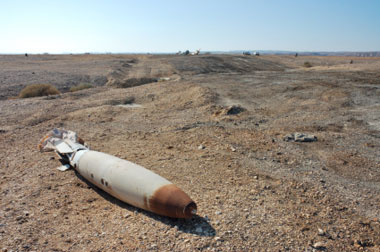Office of the Secretary of Defense: Green Technology Update
Located in the Office of the Secretary of Defense (OSD), the Strategic Environmental Research and Development Program (SERDP) and the Environmental Security Technology Certification Program (ESTCP) bring together stakeholders from academia, industry, military and other Federal agencies to coordinate DoD’s next generation green technologies. With research and development from green chemistry and smart microgrids to sustainable cleanup of unexploded ordnance, SERDP and ESTCP are taking new technologies out of the lab and implementing them in DoD organizations. Dr. Jeffrey Marqusee, Executive Director of SERDP and Director of ESTCP, explains this innovative partnership and shares its most recent green technology accomplishments:
“SERDP is a science and technology program that conducts research, and ESTCP is a demonstration program designed to transition technology out of the lab and into DoD installations. We’re a funding agency providing resources to the military, universities and private sector. We also make decisions collaboratively with the military and have a large number of very active working groups. Moreover, SERDP is a partnership between DoD, Department of Energy (DOE) and Environmental Protection Agency (EPA), so we also do collaborative research with them.
“Our development process involves a combination of academics doing basic science and people in government and industry labs doing applied work. When we demonstrate and verify, it’s a joint venture between government and leading industrial suppliers. However, the process is often dual-track – final implementation is done by industry, so they’re a partner all along the way.
“We do work with small businesses, as well as big businesses, because innovation exists across the spectrum. To engage businesses in a fair and structured way, we put out what are called broad agency announcements to solicit proposals. Small businesses might have an innovative technology, but they don’t have any understanding where it could be used in DoD, which is fine. We’ll take a look, review with the military services and find a place to demonstrate the technology if we feel there’s a match.
“DoD has hundreds of installations with literally hundreds of thousands of buildings. Our approach is to look at the technologies that have benefits broadly across DoD and match them up with the right location – whether a building or installation – to do the demonstration. This way we can look holistically at the broad needs of the Department. For example, if we’re looking at advanced solar technology, we’ll be demonstrating that in places like the Southwest. Likewise, advanced insulation and building technologies have a higher payback in colder weather climates. So, we use all our installations as a virtual test bed, matching the technologies to where they’re most appropriate.”
Green Chemistry

© iStockphoto.com/subtik
Marqusee continues: “A host of exciting things are going on with significant efforts to eliminate hazardous materials in both manufacturing and maintenance of our weapons systems. These are often chemicals like hexavalent chromium, volatile organic chemicals or things like cadmium or beryllium – all of which have been used in modern industry for decades. What we’re doing now is looking afresh at the purposes these chemicals were used for. By understanding the basic science of why these chemicals were effective, we can come up with green alternatives that not only don’t have environmental impacts but are also better products. It’s a real win-win.
“One particular example is work we’ve just finished with the Army for treating medium caliber gun barrels. Historically, these have been plated using hexavalent chromium, but concerns exist about exposure to workers as well as increased costs associated with hazardous waste disposal. Now we’ve developed and implemented a green alternative that not only gets rid of the classic environmental problems but also allows the weapons systems to last three times as long. It’s a major game changer that’s good for the environment, good for performance and will save us money over the project’s life-cycle.
“In addition, we’re trying to implement new science and technology during early development of new chemicals, like explosives propellants, so we know before making a chemical whether or not it will be green. This is one of the key principles of green chemistry and engineering – to push those issues earlier in the development cycle. We want to understand effects earlier in the process and work with that knowledge during the design stages.”
Smart Microgrids
Marqusee says that DoD will be able to decrease its carbon footprint “by reducing our energy consumption. People talk about the smart grid and its role for modernizing our electric power industry. Smart microgrids are related to that, but a little different. People see them as a stepping stone to a future energy grid that is much more efficient. The idea is to create a connection between critical buildings on an installation as well as local power generation, if you have, for example, photovoltaic solar on the roof or, perhaps, landfill gas-energy production. Microgrids are also connected to the main grid. However, we can manage the connected buildings as a collection much more efficiently, and at a lower cost, than individual buildings.
“From a military point of view, it’s critical for us to sustain operations at all times. If some event were to take down the main grid, the microgrid could continue to operate and keep the facility secure. When the main grid goes back up we can seamlessly integrate back in. We’re doing work with DOE and industry on this, and we think DoD is a good avenue to push this out.”
Sustainable Cleanup
“Another area we’ve been working on is past contamination,” says Marqusee. He explains that DoD “has a huge cleanup liability with unexploded ordnance or old bomb sites. With more than 20 million acres of contaminated land at 3300 sites and more than $20 billion of expected liability, cleanup of these sites is critical because they pose a risk to people and inhibit land redevelopment.”
Traditionally, these cleanups used a metal detector to locate possible explosive materials, in addition to digging hundreds of holes to find them. Marqusee maintains that “at one site in the Southeast, the Army had to excavate 100,000 holes to find seven bombs – imagine the costs and how slow that is.

© iStockphoto.com/leospek
We solved this tough technical problem with a process called ‘discrimination.’ By developing new sensors, understanding the problem’s physics and doing very sophisticated software development, we can now tell the size, shape, thickness and type of metal buried underground. That’s enough information to be able to tell ‘Is that a rocket or a horseshoe?’ And, we’ve begun to prove this new technology at real sites. It’s a radical and exciting change that will not only save the Department money but will speed these cleanups to a fraction of the time.”
These innovative technologies are just a few aspects of how DoD’s SERDP and ESTCP are turning the page on unsustainable operations. “Looking at engineering and materials practices, we have a legacy of historic activities that work fine and no one has bothered in decades to say ‘Is there a better way to do it?’ Now, driven by environmental and human health concerns, people are relooking at these things, incorporating the last decade of advances in the sciences and finding out ‘Hey, not only can we get rid of hazardous materials and make these processes greener, we can actually decrease life-cycle costs and sometimes even improve performance,’” concludes Marqusee.




























